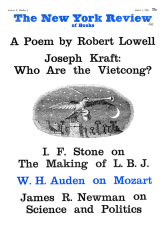In response to:
Backward and Downward with the Arts from the June 17, 1965 issue
To the Editors:
Nowhere in Calvin Tomkins’s book, The Bride and the Bachelors, does the author pretend to be an art critic. That Mr. Kramer chose to berate a gifted journalist for his lack of ability as an art critic is to begin with curious. But the ax Mr. Kramer has to grind with Mr. Tomkins is one he has been honing up for several years, so his treatment of the book as an occasion for counter-mythmaking hardly comes as a surprise. The insinuation that the lives of these artists as Mr. Tomkins presents them do not coincide with the reality of their lives is especially distasteful. If there is some kind of “inside dope” which if only known would cause us to regard these artists quite differently, then Mr. Kramer ought not to allow his reticence and good taste to confine him to innuendo. In what way, I want to know, do the lives of these artists differ from the accounts given by Mr. Tomkins? If Mr. Kramer is not prepared to spell it out, then he ought not to insinuate that discrepancies exist.
Though Mr. Kramer and others who dispute the validity of avant-garde art have convinced the literate public that it has been duped, they have not persuaded artists to turn from an art grounded not in crowd-pleasing but in internal necessity. That few are sufficiently committed to follow the artist through the complicated development of his art has been more or less normal since the Salon rejected Manet. (The late David Smith put it best when he said that the layman is not interested in art; otherwise he would not be a layman.) What has not been normal is the taking up of avant-garde art by the mass public on a gossip column level, even as serious critics reject it on the level of a closed-minded moralizing.
In this context I would suggest that Mr. Kramer’s self-righteous j’accuse, which ends up aimed at the artists themselves, has the wrong target. More responsible for the messy state of the art world are those in a position to formulate values who fall even to consider the issues. On these grounds I would accuse Mr. Kramer and the New York intellectual community in general, which, for over two decades has turned its back on the art being produced, so to speak, on its doorstep, of a fair share of the responsibility for the condition of the art world. I fail to see, for example, how Mr. Kramer’s review in any way raised the level of discourse or helped to correct the situation he deplores. On the contrary, instead of arguing the issues lucidly presented in the book he was purporting to review, Mr. Kramer ignored them in favor of re-introducing ad hominem remarks, thus coming dangerously close to the gossip-column spirit he would criticize. In other words, to evaluate Rauschenberg’s art as art and find it lacking is not the same as implying he is little more than a window dresser who through tricky P. R. has “made it.” If anyone is guilty of treating Rauschenberg as a personality rather than as an artist, surely it is Mr. Kramer.
Barbara Rose
New York City
Hilton Kramer replies:
Miss Rose seems to have got matters more than a little confused. It is the “gifted journalist” who does not “pretend to be an art critic,” and not this reviewer, who has chosen to adopt a highly selective biographical mode in writing about his subjects, and who thus does pretend to bring us the “inside dope.” For Miss Rose, apparently, this much of the “dope” will make do for the whole story: if her letter is any guide, she is indeed the ideal reader of such “dope.” I am sorry it comes as such a shock for her to be told that the lives of these artists are not exhausted by Mr. Tomkins’s clever treatment of them, but the price of such innocence is often a shock of this sort. Far from dealing in innuendo or “personalities,” I simply take it as a commonplace that no man’s life conforms to the facile shape which the “profile” form inevitably confers on it. Anyone not sophisticated enough to recognize this simple truth is not only ill-informed about the subjects in question, but about life itself.
The “New York intellectual community” can, I am sure, look after itself. Speaking only for myself, then, I must reject Miss Rose’s ignorant remark about turning my “back” on the art being produced in New York. On the contrary, it is my eye and my pen that have been firmly focused on this art for more than a decade, as Miss Rose ought to know. But then, her innocence is apparently boundless. It seems never to have occurred to her that to know this art, and know it well, is not necessarily to love every last one of its manifestations.
This Issue
August 5, 1965



